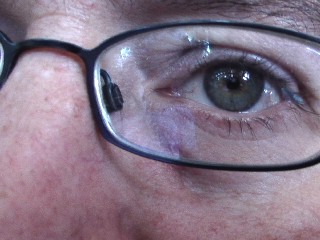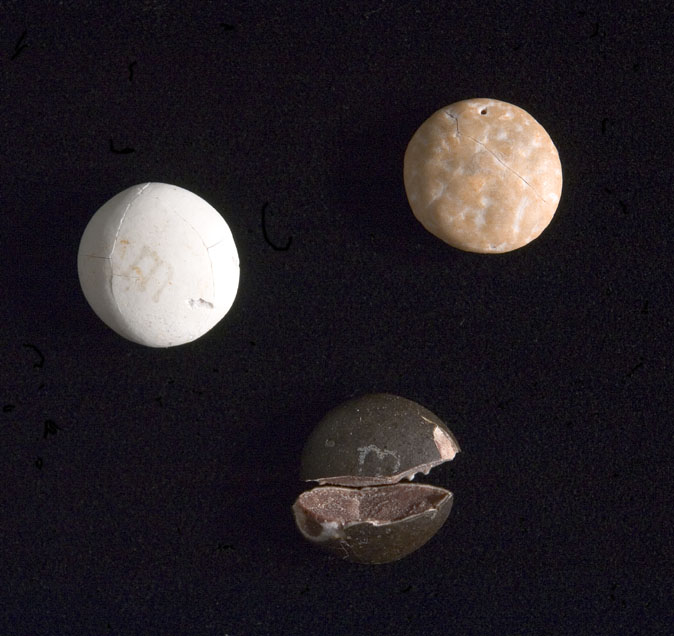Artists on Artists: Sean Connaughty and the History of the Earth
Sean Connaughty here describes his work and how and why he makes it. This protean artist, well known for his paintings, also produces video and sound as well as more undescribable artifacts. Click the links in the article to hear and see the art.



Recently, I moved to a new apartment and began sorting through the material I have accumulated. I started to look back. I began to archive the work I’ve made over a period of more than twenty years.
I’ve been sifting through hundreds of tapes and myriad documents. Unfortunately, a large portion of the earliest works are lost. Some were only moments in time, works of vivid imagination, done in collaboration with my old friend Elliot, The material evidence of this work – the cassettes and films – are deteriorated beyond recovery and the stories we wrote have long since disappeared beneath the Eden Prairie landfill. After the fact, I realize that my life’s work has been one extensive piece, It’s still going on.
In 1984 I made the conscious decision to attend art school and become an ‘artist’. I began to document my work.
As I’ve continued this has become a growing concern, I’ve become painfully aware of the transience of artistic materials. I’ve lost many pieces beyond recovery, A year’s work was buried beneath rubble and another 20 paintings were destroyed while I was in grad school in 2000.
Fears about losing my art lead me to do extensive documentation. Seeing my work recorded, I began to think about what would be left behind. This led me to consider how my work would be viewed after my passing, which in turn led inexorably toward the idea of the Tome.
The Tome is intended as an archive and a history, a posthumous body of work. I still am trying to formulate why it is important for this work to viewed as posthumous, but I do know I want the work to be viewed from a distance: so it can be seen without a filter. It wasn’t until I was well under way with the Tome that I learned of Marcel Duchamp’s “Boites en Valise”. These are mini retrospectives contained within small boxes and briefcases–similar to what I am doing with the Tome. On the surface it is a retrospective of works created throughout the lifetime of one person, an accumulation of art encompassing multiple mediums and genres.
Over the years I’ve made a continuing series of works dealing with language; they often point out its fallibility as a medium for communicating ideas. I do believe, though, that something does survive the passage to the listener/viewer. I believe in the possibility of successful communication between the artist and the viewer. Hence my concern for documentation in the hope of the viewer’s recognition of what I have done.
More, I have been basking in that moment, the one where your work surpasses yourself and you feel a sense of connection with something greater than yourself. That is what I live for. I have always sought experimentation in order to gain access to that connection.
An experimental work that calls attention to the degradation and the resilience of an idea– 20th generation approximation— was generated from a discussion I had with Ron Dahl in his critical studies class, based on my assertion that each word is only an approximation of an idea. A word is an attempt at description that results in a symbol which is less than the idea itself. To illustrate this concept I recorded a song from a record, “Angola Prison Blues” (Lonesome Blues by Guitar Welch). I played this record through a battered tweeter from a trashed car speaker, The sound was recorded through a microphone onto a cassette. This was played again through the damaged speaker and recorded. This process was repeated 20 times. (Go to Twentieth Generation Approximation on my mnartists.org site to hear it.)
The result is distorted and diminished version of the original, But I also feel that something persisted and is still present. There was a treatise I wrote during that time “Love Letters to Language”, which delved into this notion of language as approximation. In 1984 I made a piece called “Thought Map.” The text was derived from periodically recording random thoughts every 10 minutes.
In 1990 I created a series of text pieces called
“Time and Space Study”. The text was inscribed using heavy, steel letter-stamps on found pieces of wood. They state:
I AM OVER THE RIVER NOW.
I AM IN THE CAVE NOW.
I AM OVER THE RIVER NOW.
These pieces were recordings of a sort.
They were made, in truth, in the locations mentioned. I was trying to capture something that cannot be captured, and making a statement about it. There are accompanying photos, which served as proof of their authenticity. (See “Time and Space Study” and the accompanying documentation.)
The heart of the Tome will be a set of 30 small photogravure prints entitled “A History of the Earth.” The obscure and deeply personal nature of this imagery is in paradox with its grandiose title. Paradoxically, it is intended to express universal ideas through personal experience—which is our only source for universal ideas. It is a kind of personal archaeology.
Beyond being seen as a documentation of my work, “A History of the Earth” and The Tome are created and presented as a collection of historical and archaeological documents: a history of the earth. Seen without the filter of artworld expectations, the work is embedded with countless bits of information, which speak to technological capabilities and geological and meteorological information, as well as cultural, political and personal experience. There is no first-person involvement in the presentation of the work in The Tome, so that it is viewed from a detached point of view. (See my mnartists.org site for more on this.)
I have begun improvising with words, in a format which more closely resembles song than the aforementioned 20th generation approximation. The creation of these songs is little different than other works more recognizable as Art. In fact, they employ the same strategy I have used with painting; that is, drawing from the random field and trying surpass my own imagination, and its inhibitions. One can watch a live thing emerge from a random collection of information. I am curious about the nature of those narratives and where they come from. I find voice to be an extremely ergonomic tool. It reacts almost instantaneously, It’s a very responsive medium, while painting still requires a host of technical requirements, and requisite materials. La Mano Poderosa is one of those pieces.
The Tome will contain high resolution digital photographs enumerating other conceptual works I have created, and am still creating. One such piece, Citizen, was created in 1988 by smashing a television and fitting it inside of a jar, and accompanying the television is a second jar, which contains the accumulated receipts from one year.
“A History of the Earth (the Video)” is a series of videos that document the passage of one year (2005) from a very close perspective, from the myopic view of a human, urban dweller in the early twenty-first century. The videos note climatic activity, the diversity of species, human anatomical, cultural, commercial and economic structure, from a deeply personal vantage point. It is a strange paradox, to be addressing such polar concerns in one act of expression.
Some examples:
Karma
Advertisement
Looking back on the entirety of this alternate body of work, so different from my paintings, I see that it truly is one piece. This is reassuring to me now. I have always believed in the idea of non-intentionality. All actions that consciously attempt to approximate natural behavior are unnatural. This is self-consciousness. One cannot act natural. Natural action comes from the suspension of intentionality and a suspension of self consciousness. I attempt to express myself without the imposition of intentionality, or self-consciousness.
In mining a territory that is so characteristically unfamiliar, new abysses are unveiled with each discovery, illumination of one area reveals another that remains unlit. It is a process of perpetual discovery, but through it all there is a thread of purpose.
Note:
The Tome:
All contained within a 5x5x5” cube
There will be an edition of 13
Each cube is a painting
Which is part of a larger painting, which will be displayed in its entirety in an exhibition.
The Tome contains:
30 photogravure prints “A History of the Earth”
10 CD’s of original sound art and unconventional music.1984-2005
The Hour of Decision, Poison in the Water, Blacklock,
Five Hands Tall, Viscous Fluid #1,#2, #3
Skinny Poop Sagas, The Lost God Ballads,
And March Madness!
1 DVD “A History of the Earth (The Video)”
Documents printed on 5X5” paper